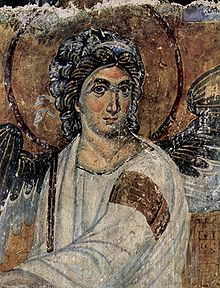White Angel (Serbian: Бели анђео / Beli anđeo) is a detail of one of the best known frescoes in Serbian culture[1] in the Mileševa monastery, Mironosice na Hristovom grobu (Мироносице на Христовом гробу, the Myrrhbearers at Christ's tomb),[2] dated c. 1235 in Serbia during the reign of King Stephen Vladislav I of Serbia. Considered one of the most beautiful works of Serbian and European art from the High Middle Ages, this fresco is considered to be one of the great achievements in European painting.[2] It depicts the arrival of the myrrhbearers at the tomb of Christ on Sunday morning, after the events of the Crucifixion. Sitting on the stone is the Angel of the Lord dressed in a white chiton, whose arm shows the place of Christ's resurrection, and his empty tomb.


Location and history
editThe fresco is located in the Mileševa Monastery near Prijepolje, on the southern wall of the church and the identity of its author is unknown.[2] In the 16th century, the White Angel was over-painted with another fresco, and so was hidden until the 20th century when the fresco was restored.[2]
Trivia
editA picture of the White Angel of Mileševa was sent as a message in the first satellite broadcast signal from Europe to America after the Cuban Missile Crisis, as a symbol of peace and civilization.[3] Later, the same signal, containing the White Angel, was transmitted to space in an attempt to communicate with extraterrestrial life forms.[4][5] However, this has been disputed, as no official NASA or other space agency sources have been found to confirm this claim.[6]
See also
editReferences
edit- ^ "White Angel – the Mileševa monastery". Via Balkans Travel Portal. 22 December 2010. Retrieved 19 December 2014.
- ^ a b c d "Manastir Mileševa - crkva Belog anđela" [Mileševa Monastery - the Church if the White Angel] (in Serbian). Večernje novosti. 5 August 2012. Retrieved 19 December 2014.
- ^ "Манастир Милешева и Бели Анђео" [Mileševa Monastery and the White Angel] (in Serbian). Tourist Organisation of Preijepolje. Retrieved 19 December 2014.
- ^ Mihaljčić, Milena (2013). 52 vikenda u Srbiji [52 Weekends in Serbia] (PDF) (in Serbian). Belgrade: Tourist Organisation of Serbia. p. 30. ISBN 978-86-6005-278-2.
- ^ Lončar, R. (25 November 2012). "Filaret zinuo na Belog anđela" [Filaret Gasps at the White Angel] (in Serbian). Vesti Online. Retrieved 19 December 2014.
- ^ Kosanović, S. (19 July 2020). "Beli anđeo nije poslat u svemir" [White Angel was not sent to space] (in Serbian). FakeNews.rs. Retrieved 29 June 2021.
External links
edit- "Zagonetni pogled na licu Belog Anđela pokazuje vaskrsenje?" [Mysterious Eyes of White Angel Show Us the Resurrection] (in Serbian). Vecernje novosti. 19 April 2014. Retrieved 19 December 2014.